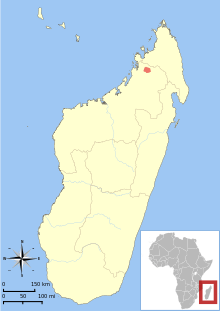Sambirano woolly lemur
The Sambirano woolly lemur (Avahi unicolor), also known as the Sambirano avahi or unicolor woolly lemur, is a species of woolly lemur native to western Madagascar.[4]
| Sambirano woolly lemur | |
|---|---|
| Scientific classification | |
| Kingdom: | Animalia |
| Phylum: | Chordata |
| Class: | Mammalia |
| Order: | Primates |
| Suborder: | Strepsirrhini |
| Family: | Indriidae |
| Genus: | Avahi |
| Species: | A. unicolor |
| Binomial name | |
| Avahi unicolor | |
 | |
| Distribution of A. unicolor[1] | |
Description
The species are located in Cacamba, on the peninsula of Ampasindava, in northwestern Madagascar . This sub-species is distinguished form Avahi occidentalis by its lack of the white facial outline and the lack of the black hairless circles that surround the eyes . The face itself is slightly more pale than the upper head which creates a slight contrasting facial outline caused by the fur length and consistency (facial hair is short and not curled in comparison to the rest of the body) . The contrasting facial outline has a small fur spot above the nose and the forehead that presents the appearance of a dark line . Its eyes are maroon with black, hairless eyelids. The snout is also black and hairless, but the corners of the mouth have a white tint. The fur of the head and body is a light gray-beige, and has a sightly curled, freckled appearance. Its tail is gray-brown or reddish-brown, while the base is a pale brown or cream color. The back is slightly darker in the shoulder-blade area. The lower body's limbs are an off-white color, while the fur on the chest, belly, and inner limbs is fairly thin and light-gray in color.[3]
Habitat
This species is very poorly known, since so far there have been just a few specimens found. They might be living in the Sambirano region in north-western Madagascar. Probable limits of their distribution are the Sambiran River in the north and the Andranomalaza or Maevarano River in the south.[1]
Conservation
As It is not known to which degree the species is hunted, deforestation is probably the main threat it has to face. It is listed on Appendix I of CITES. Since there are only a few known specimens in protected areas, Additional research and extending the reserves would be essential.[1]
References
- Louis, E.E., Bailey, C.A., Sefczek, T.M., Raharivololona, B., Schwitzer, C. & Wilmet, L. (2020). "Avahi unicolor". IUCN Red List of Threatened Species. 2020: e.T41579A115579946. Retrieved 10 July 2020.CS1 maint: uses authors parameter (link)
- "Checklist of CITES Species". CITES. UNEP-WCMC. Retrieved 18 March 2015.
- Thelmann, U.; Geissmann, T. (2000). "Distribution and geographic variation in the western woolly lemur (Avahi occidentalis) with description of a new species (A. unicolor)" (PDF). International Journal of Primatology. 21 (6).
- Groves, C. P. (2005). Wilson, D. E.; Reeder, D. M. (eds.). Mammal Species of the World: A Taxonomic and Geographic Reference (3rd ed.). Baltimore: Johns Hopkins University Press. p. 119. ISBN 0-801-88221-4. OCLC 62265494.
